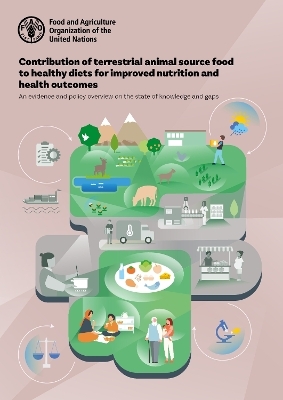
Contribution of terrestrial animal source food to healthy diets for improved nutrition and health outcomes
an evidence and policy overview on the state of knowledge and gaps
Seiten
2023
Food & Agriculture Organization of the United Nations (FAO) (Verlag)
978-92-5-137536-5 (ISBN)
Food & Agriculture Organization of the United Nations (FAO) (Verlag)
978-92-5-137536-5 (ISBN)
Terrestrial animal source food (TASF) provides higher-quality proteins than other foods, so higher dietary intakes of TASF can have positive effects on nutrition, health and cognition. This publication focuses on the downstream impacts of TASF consumption as part of a healthy diet and provides a systematic review of its contribution to health.
Diverse foods derived from livestock production systems, including grazing and pastoralist systems, and from the hunting of wild animals and wildlife farming, provide high-quality proteins, important fatty acids and various vitamins and minerals - contributing to healthydiets for improved nutrition and health. Preferences and socio-economic and cultural factors, which vary across agrifood systems and population subgroups, can shape demand for, and consumption of, terrestrial animal source food. Livestock species - mammals, birds and insects - are adapted to a wide range of environments, including areas that are unsuitable for crop production. Globally, more than a billion people depend on livestock value chains for their livelihoods. Small-scale ivestock farmers and pastoralists make up a large proportion of livestock producers. Well integrated livestock production increases the resilience of small-scale farming systems and thus enables poor farmers, in particular, to better cope with disruptions. Livestock also provide other important ecosystem services in landscape management, provide energy and help to improve soil fertility. Rangeland or grassland ecosystems occupy some 40 percent ofthe world's terrestrial area. Livestock keepers raise grazing animals to transform grassland vegetation into food
Diverse foods derived from livestock production systems, including grazing and pastoralist systems, and from the hunting of wild animals and wildlife farming, provide high-quality proteins, important fatty acids and various vitamins and minerals - contributing to healthydiets for improved nutrition and health. Preferences and socio-economic and cultural factors, which vary across agrifood systems and population subgroups, can shape demand for, and consumption of, terrestrial animal source food. Livestock species - mammals, birds and insects - are adapted to a wide range of environments, including areas that are unsuitable for crop production. Globally, more than a billion people depend on livestock value chains for their livelihoods. Small-scale ivestock farmers and pastoralists make up a large proportion of livestock producers. Well integrated livestock production increases the resilience of small-scale farming systems and thus enables poor farmers, in particular, to better cope with disruptions. Livestock also provide other important ecosystem services in landscape management, provide energy and help to improve soil fertility. Rangeland or grassland ecosystems occupy some 40 percent ofthe world's terrestrial area. Livestock keepers raise grazing animals to transform grassland vegetation into food
| Erscheint lt. Verlag | 25.4.2023 |
|---|---|
| Zusatzinfo | col. figs, tables |
| Verlagsort | Rome |
| Sprache | englisch |
| Themenwelt | Medizin / Pharmazie ► Allgemeines / Lexika |
| Sozialwissenschaften | |
| Technik | |
| Weitere Fachgebiete ► Land- / Forstwirtschaft / Fischerei | |
| ISBN-10 | 92-5-137536-4 / 9251375364 |
| ISBN-13 | 978-92-5-137536-5 / 9789251375365 |
| Zustand | Neuware |
| Haben Sie eine Frage zum Produkt? |
Mehr entdecken
aus dem Bereich
aus dem Bereich
medizinischer Grundwortschatz und Fachwörterlexikon für Pflegeberufe
Buch | Softcover (2022)
Börm Bruckmeier Verlag
CHF 26,60
Kitteltaschenbuch für den Auslandsaufenthalt
Buch | Softcover (2016)
Lehmanns Media (Verlag)
CHF 20,90


